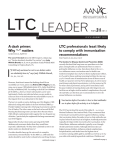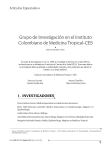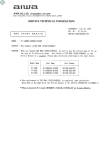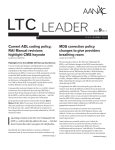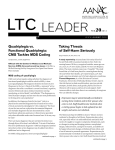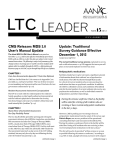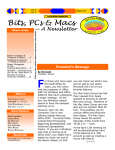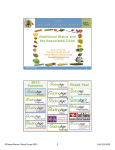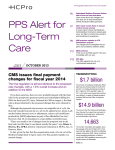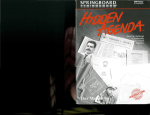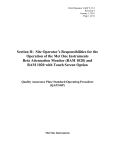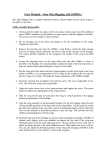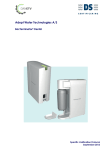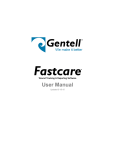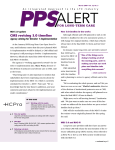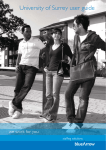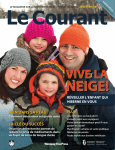Download LEADER - aanac
Transcript
W W W. A A N AC .O R G LTC AANAC’s Board and Expert Advisory Panel Working with CMS on Clarifications By Jennifer Pettis, rn, bs, wcc, rac-mt, Chair of the AANAC Expert Advisory Panel APRIL 2012 LEADER The AANAC Expert Advisory Panel and members of the AANAC Board of Directors recently met, via conference call, with representatives the Centers for Medicare and Medicaid Services (CMS) to discuss concerns that members have communicated based on the recently released April 1, 2012 RAI User’s Manual changes. Below are the issues which the Expert Advisory Panel raised with CMS: •The inability to correct Assessment Reference Dates (ARDs) and Reasons for Assessments (RFAs) and resubmit the same assessment (and instead requiring the provider to complete a new assessment with the current date as the ARD); •Unexpected discharges resulting in Change of Therapy Other Medicare Required Assessment (COT OMRAs) that should have been done because the assessment that stopped the seven day rolling window was not used for payment due to the discharge (for instance the 30 day was done on day 27—day seven of the COT observation period—but the patient went to the hospital on day 30 so the 30 day was never used for payment resulting in a COT that should have been done on the 27th); and •The inability to submit MDSs done for reasons other than those completed for OBRA and PPS purposes. Additionally, the Expert Advisory Panel requested clarifications as to whether or not to restart the Prospective Payment System (PPS) schedule when a resident with Medicare replacement 1 3 plan converts to traditional Medicare. CMS reported clarity on this issue is forthcoming. The AANAC Expert Advisory Panel appreciates the ability to discuss these concerns with CMS and will keep members apprised of any updates as soon as they are available. As members are aware, CMS has issued further clarifications and the Expert Advisory Panel encourages members to, as CMS stressed in the clarification memo, take full advantage of the Encoding Period to avoid repercussions of the first two items that were discussed with CMS. The AANAC Expert Advisory Panel appreciates the ability to discuss these concerns with CMS and will keep members apprised of any updates as soon as they are available. ● Courage doesn’t always roar. Sometimes courage is the quiet voice at the end of the day saying “I will try again tomorrow.” —MARY ANNE RADMACHER 2011 MEMBERSHIP SATISFACTION SURVEY AANAC Announces Results of 2011 Membership Satisfaction Survey From the AANAC Board of Directors The AANAC Board of Directors would like to thank the 1568 members (14%) who completed the recent Membership Survey. Having so many participants ensures that the results have high statistical reliability. With more than Summary of results We asked numerous questions to identify the extent to which members agree with our current priorities, which guide AANAC’s strategic planning. Below is a brief summary of the survey results. We are happy to report that respondents indicated great satisfaction with the return on investment they receive as AANAC members with 78% of respondents agreeing that AANAC is their primary source of accurate, timely and affordable information and tools. The single most important need you look to AANAC to fulfill is “Having skills/knowledge to conduct accurate and effective assessment” with 95% rating this very important. 12,000 members, this feedback helps us a great deal in serving your needs. The Board and its Membership Linkage Committee are analyzing the survey results and will be addressing next steps throughout the year. At the April AANAC conference in Jacksonville, the Board is hosting a roundtable event to explore some of the key results further with the membership through a focus group style session. If you are interested in attending this session, please contact AANAC to add this session to your conference registration. 2 •In rating overall satisfaction with AANAC membership, 89% reported being very satisfied or satisfied, 9% were neutral, and fewer than 2% reported dissatisfied. •The single most important need you look to AANAC to fulfill is “Having skills/knowledge to conduct accurate and effective assessment” with 95% rating this very important. •Members also ranked “Being knowledgeable about regulations/ public policy and their implications” as being important (96%). •Perhaps the most significant issue rated as important (95%) but which few members (31%) believe to be currently the case is that “Long term care nursing is positively perceived within the nursing profession.” The survey process and results exemplified how important it is that we hear from you. Overall, the survey responses validate that current “Results Priorities” in our strategic planning are in sync with what you want, and you rate AANAC’s performance extremely well! We don’t take that for granted. We ask that when we reach out to you in the future, whether through on-line surveys, forums, focus groups or other membership events - please DO connect with us to help us serve you. Sincerely, Carol Siem, Board Chair Carol Maher, Chair, Membership Linkage Committee A A N AC LT C L E A D E R 4 . 3 . 2 012 PPS ASSESSMENTS Unscheduled PPS assessments: Management tips Caralyn Davis, Staff Writer Successful management of unscheduled PPS assessments is critical to avoiding default days and provider-liable days, says Robin Hillier, cpa, stna, lnha, rac-mt, president of RLH Consulting in Columbus, Ohio. “That certainly makes administration a lot happier, and there’s really less work for everyone because you’re not playing catch-up.” AANAC master teachers offer the following suggestions to help MDS coordinators keep track of—or even avoid—end-of-therapy (EOT), changeof-therapy (COT), and start-of-therapy (SOT) Other Medicare Required Assessments (OMRAs): Meet with therapy daily There needs to be a daily meeting between the MDS coordinator and the rehab coordinator, says Lisa Hohlbein, rn, bs, rac-mt, director of clinical reimbursement for LeaderStat in Columbus, Ohio. The meeting should include a review of treatment in intensity, planned or unplanned,” she says. “They also need to review possibilities for potential discharge. All of these issues need to be reviewed because they have the potential to trigger an unscheduled assessment.” Schedule afternoon meetings At many facilities, those rehab issues are discussed during daily PPS meetings, which typically are held in the early morning hours, notes Hillier. “Providers should either move their PPS meetings to mid-to-late afternoon, or they should have a quick follow-up meeting in midto-late afternoon with, at minimum, the MDS nurse and therapy. The problem is: When you have discussions in the morning, you plan based on what you think is going to happen for the day, not what actually happened.” Consider this example: Resident X is scheduled for therapy five days a week, Monday through Friday. If the facility has a PPS meeting on Friday morning, “they assume this resident is going to do the therapy that is scheduled during the day,” Hillier points out. But for whatever reason, Resident X refuses therapy. That establishes day 1 of the three-day window for the EOT OMRA going into a two-day weekend. “The MDS coordinator and the rehab coordinator need to examine rehab patterns to look for any changes in intensity, planned or unplanned,” says Lisa Holbein. minutes and the number of days and disciplines. “The MDS coordinator and the rehab coordinator need to examine rehab patterns to look for any changes 3 “If the MDS nurse and the rehab director don’t have another 10-minute meeting late in the day on Friday to say, ‘Resident X didn’t receive therapy as anticipated,’ then the MDS nurse doesn’t know that the potential is there for the EOT OMRA, and the rehab director might not realize that the resident didn’t get therapy, possibly missing an opportunity to schedule a therapist to pick up this resident on Saturday and make up the missed Friday therapy.” Late-afternoon meetings give providers greater flexibility, allowing them to identify residents who are potential candidates for unscheduled assessments as early as possible, says Hillier. “That’s particularly important going into weekends and holidays.” continued on page 5 A A N AC LT C L E A D E R 4 . 3 . 2 012 SKIN CARE Pressure Ulcer Prevention and Management Betty Frandsen, rn, nha, mha, c-ne Sores e r u s s e r F314 P ehensive r the comp n the o d e s Ba esident, r a f o nt Assessme e that— st ensur u m y t i l lity faci the faci s r e t n e velop nt who s not de e o d s e A reside r so al’s pressure individu e h t s without s e l that sores un nstrates o m e pressure d n o conditi clinical le; navoidab u e r e w es they sure sor s e r p g n and nt havi reatment A reside t y r a s s vent nece ing, pre l a e h receives e t to promo w sores services event ne r p d n a n infectio eloping. from dev For each pressure ulcer, whether present on admission or developed afterward, determine the factors that influenced its development, the resident’s potential for development of additional areas, or for deterioration of the pressure ulcer. A new pressure ulcer suggests that the adequacy of the prevention plan should be reevaluated. Include the following factors in the assessment of the ulcer: Type (pressure-related versus nonpressure-related), Stage, Characteristics, Monitoring progress toward healing and for potential complications, Presence of infection, Pain (assess, monitor, treat), Dressings and treatments. Pressure Points and Tissue Tolerance The intent of F314 is that a resident does not develop a pressure ulcer unless it is clinically unavoidable. Employees must understand what ‘unavoidable’ means, and be equipped to attain that standard of care. An unavoidable pressure ulcer is one that develops despite the following: It is critical that clinical staff conduct regular skin assessments for each resident identified as at risk for development of pressure ulcers. Assessing resident’s skin helps team members design individualized prevention strategies. Pressure ulcers typically are located over boney prominences, although they may develop where pressure impairs tissue circulation, such as pressure from positioning or from medical devices like oxygen tubing over ears and at the nares. •The resident’s clinical condition and pressure ulcer risk were thoroughly evaluated Nutrition or Hydration Deficits •Interventions were defined and implemented consistent with resident needs, goals, and industry standards of practice Residents with nutritional or hydration deficits experience weight loss, which indicates a caloric imbalance. A resident with a pressure ulcer who continues •Staff monitored and evaluated the impact of the identified interventions •Approaches were revised as appropriate. Conversely, an avoidable pressure ulcer develops because staff do not follow these expected steps. Education for nursing staff should include the following topics: 4 Assessment and Treatment continued on page 13 A A N AC LT C L E A D E R 4 . 3 . 2 012 Unscheduled PPS assessments, continued from page 3 Cultivate relationships Regular meetings are important, but they are just the start, notes Hillier. “It goes without saying: It is increasingly important for MDS and therapy to have a good working relationship so that they communicate well—and frequently— throughout the day. The only way to truly stay on top of unscheduled assessments is for MDS and therapy to work together as a collaborative team every day, as opposed to finger pointing at each other. Then you will always have accurate, real-time information, which is going to keep you from getting surprises—and being late on assessments or finding out that you missed assessments.” Ramp up activity on Thursday, Friday Your Primary Resource for Medicare Coverage MDS nurses need to remain vigilant five days a week to manage unscheduled assessments, “but Thursday and Friday are the most important days to set up your weekend,” advises Amy Franklin, RN, CDON, RAC-MT, director of RAI for Metron Integrated Health Systems in Grand Rapids, Mich. “Facilities have a maximum of two days to set the assessment reference date [ARD] after the ARD window for an unscheduled assessment has passed. So, for example, if you think you need a COT ARD where day 7 falls on Saturday or Sunday, enter it into your computer by Friday. You can always cancel the assessment on Monday, but you won’t be late.” AANAC’s Medicare University (MU) helps you know “what you don’t know” when it comes to Medicare. We cover the complex details in a simple, understandable and concise manner that provides you the knowledge to sort through the paperwork and requirements, improve your daily meetings and turn on the light for others in your facility. Pay attention to payment But, don’t take our word for it. Listen to what our students have said: Understanding the rules for unscheduled PPS assessments is not easy these days, given that CMS has already revised some of the instructions its officials issued during the MDS 3.0 National Conference in early March. (Look for the latest clarification memo here.) “However, MDS coordinators need to think about how the decisions they make impact payment,” says Hohlbein. “They must have an awareness of ARDs and how scheduled assessments relate to unscheduled assessments. For example, they need to be able to determine whether it will benefit the facility to do a scheduled assessment with an ARD set before an unscheduled assessment.” Share monitoring duties “There is a misconception among some MDS nurses that the responsibility for monitoring therapy for unscheduled assessments solely rests on the therapy department,” says Hillier. The problem with that attitude is that the penalty lies on the SNF, not on the contract therapy company or the therapy department alone, if an unscheduled MDS is missed. » “This course re-energized our eyes to teach staff to increase our awareness and get us back on track” » “This course has given me additional support and confidence for my position with the MDS. I feel more secure with the information I have learned” » “This course has really helped us tighten up our current practices” Become a student of accurate reimbursement. Click here to learn more, or register today. “So both the MDS department and the therapy department should be equally responsible for monitoring therapy throughout the week for residents who are on therapy continued on page 6 5 A A N AC LT C L E A D E R 4 . 3 . 2 012 Unscheduled PPS assessments, continued from page 5 caseloads,” she advises. “If you are saying, When Sunday is the ARD for an MDS, ‘That is therapy’s job,’ and somehow an “you are setting up your COT observation EOT OMRA or a COT OMRA gets missed, period going forward to be Monday it ultimately hurts the facility.” through Sunday,” she points out. “And that gives you the most flexibility to That monitoring can occur via “daily have residents hit their therapy level reporting by therapy at the end of the during that week. If they miss therapy day, or the MDS nurse can have daily one day from Monday to Friday, you access to the therapy treatment logs,” have the option to provide therapy suggests Hillier. “But staying on top of on Saturday or Sunday. However, if EOT and COT OMRAs is such a critical your Saturday or Sunday falls at the thing that you really need two sets of beginning of your COT observation eyes looking at it.” period instead of at the end, and you are not normally scheduling the resident Try to set Sunday ARDs for for therapy on the weekends, then you scheduled PPS MDSs already missed the ability to deliver “If you are going into a window for a those two days. That makes it harder if scheduled PPS assessment, and you something happens during the week, determine that you’ll get the same RUG and the resident misses a day of therapy.” score no matter which ARD you pick (for example, day 13 and day 18 for the 14-day Use the time that CMS gives you assessment will both generate the same MDS coordinators are understandably RUG), you should consider using Sunday under pressure to complete and submit as the ARD,” recommends Hillier. MDSs at the end of the month because 6 the facility can’t bill Part A until the MDSs have been accepted into the QIES Assessment Submission and Processing (ASAP) system, acknowledges Hillier. “But aside from that end-of-the-month pressure, MDS nurses can obtain more flexibility simply by giving themselves a few more days between when they set the ARD and when they complete the MDS, sign off that it has been encoded, and submit it.” Hillier offers this example: On day 27 of the Part A stay, which is day 7 of the COT observation period, Resident Y potentially needs a COT OMRA because one therapy discipline has discharged her, resulting in a drop in therapy RUG category. The MDS nurse decides to avoid doing the COT OMRA by completing the 30-day PPS MDS with an ARD of day 27. “In this situation, MDS nurses often will set the ARD for the 30-day MDS on day 27, complete that MDS on day 28, and continued on page 7 A A N AC LT C L E A D E R 4 . 3 . 2 012 Unscheduled PPS assessments, continued from page 6 SELECT THE BEST INGREDIENTS. submit it on day 28 or day 29,” she points regulations, “but once you set the out. “The problem with that is: If this reference date timely, you have 14 days resident discharges unexpectedly on day to complete the MDS, and then you have 31, for example, and goes to the hospital, another 14 days to submit the MDS, the The best recipes start with quality ingredients. do the best resumes that 30-day MDS will not be used for firstSo seven of which is that encoding payment. The new rules say that you need and job postings.. period where you could still make to have a COT OMRA, but that COT OMRAAANACareer provides the resources that help promote changes to it,” she notes. “So many of the your best assets to launch yourself will now be late because the ARD can’t be into a new role or entice prospective employees into applying struggles with unscheduled assessments for your job. set any earlier than day 31, four days after could be avoided if providers weren’t Employers—Want to know how effective your ad is? AANACareer day 7 of the COT observation period.” quite so quick to get assessments provides you with job response metrics to help you track candidate completed and out the door as soon as However, if the MDS nurse in this activity that your post is generating—in real time. they set that ARD.” example had set the ARD for the 30-day Job Seekers—When you only have 10—20 seconds to impress a MDS as day 27, but not been in such a prospective employer, what are the key ingredients to include in a Double-check assessment types hurry to submit that MDS, “when the resume? We’ll give you the first one: resident went to the hospital on day 31 “With theAlways new rules formind inactivations, using 1. Focus on the employer’s needs, not yours. keep in what and you realized you needed a COT instead an incorrect item set and not catching you can do for them, not the other way around. Always incorporate these of the 30-day, you could just change the the error until after submission makes thoughts into the mix on your resume. type of assessment because that MDS is the facility subject to default payment not locked and submitted yet,” advises days, at minimum, or even provider-liable Hillier. “That would save a lot of work days,” says Franklin. “So it’s a good idea having to inactivate the 30-day and three do a ingredients for a successful resume? Visit Want to know the other find out. to institute a today simple,to practical review of new COT, which is going to be late.” assessment types for both scheduled and unscheduled PPS assessments.” MDS nurses have to set the ARD timely to be in compliance with Medicare continued on page 8 SELECT THE BEST INGREDIENTS. The best recipes start with quality ingredients. So do the best resumes and job postings. AANACareer provides the resources that help promote your best assets to launch yourself into a new role or entice prospective employees into applying for your job. Employers—Want to know how effective your ad is? AANACareer provides you with job response metrics to help you track candidate activity that your post is generating—in real time. Job Seekers—When you only have 10 – 20 seconds to impress a prospective employer, what are the key ingredients to include in a resume? We’ll give you the first one: 1. Focus on the employer’s needs, not yours. Always keep in mind what you can do for them, not the other way around. Always incorporate these thoughts into the mix on your resume. Want to know the other three ingredients for a successful resume? Visit 7 today to find out. A A N AC LT C L E A D E R 4 . 3 . 2 012 Unscheduled PPS assessments, continued from page 7 At Franklin’s facilities, MDS nurses use a paper 100-day PPS tracker. “They are going to do a double-check system,” she explains. “They are going to make a check mark when they first set their ARD. Then two days later, they are going to make another check mark to make sure that that is the right assessment, that they’re using the item set they really wanted. It’s almost like doing a medication reconciliation.” Identify operational fixes EOT and COT OMRAs often become necessary because of operational activities that the provider should consider doing differently, says Hillier. “For example, residents who are going to go out for a follow-up doctor’s appointment on Monday are always potentially dangerous. They’re often gone most of the day, and even if therapy is still in the building when they return, sometimes the residents won’t participate in therapy because they are tired or in a bad mood. Many residents don’t have therapy on Saturday or Sunday. Consequently, if they miss Monday, they will be in an EOT OMRA situation.” Keep the IDT in the loop “All the disciplines that participate in the MDS need to be armed with knowledge,” says Hohlbein. “MDS coordinators should do some teaching so that the The solution: When a facility admits interdisciplinary team (IDT) members a resident with orders for a follow-up understand why we are scheduling appointment scheduled for a Monday, the unscheduled assessments and what standard procedure should be for facility potentially triggers them.” staff to try to change the appointment to a different day of the week where the Don’t forget billing resident missing therapy won’t result Whoever handles the facility’s Part in three consecutive days without A billing needs to know the correct therapy, suggests Hillier. “Furthermore, assessment indicator (AI) code and you should try to schedule follow-up the number of days to be billed for appointments for the afternoon, which each unscheduled assessment, says would allow you to deliver therapy to Hohlbein. “Those items should be residents in the morning before they go reviewed by the MDS coordinator, out to the follow-up appointment.” the business office, and rehab before Often, facilities that take the time “to claims are submitted to make sure adjust scheduling to set up the resident to everyone has accurate information.” ● be more successful hitting therapy targets will reduce the need to do unscheduled assessments,” she points out. “QMs for MDS 3.0” IS COMING APRIL 1, 2012 www.aissystems.com Commencing October 1st 2011 the MDS 3.0 assessment data collected at your facility will be used by CMS for the new Quality Measure (QM) reports. The new QM reports will be made available starting April 1st 2012. In order to help your organization be better prepared for the new QMs, AIS has created a new eLearning module called “QMs and the MDS 3.0”. See what AIS is doing to help educate your staff on all of the recent changes. Contact [email protected] for more information. AIS is a provider of comprehensive, on-demand MDS 3.0/RUG IV education for SNFs. AIS provides solutions to support RAI education 365 days a year through a convenient Internet delivery of Web-based Training, Competency Testing and Education Analytics. AIS’ solutions are easy to use, provide a substantial “Return on Investment” and play an important role in reducing risk in the areas of reimbursement, survey compliance and quality of care. AIS’ solutions are being used by the most influential Providers in the LTC Industry encompassing over 2,500 Long-term care centers in three countries around the world. 8 A A N AC LT C L E A D E R 4 . 3 . 2 012 Q+A After our annual survey everyone is so down. How do we avoid falling into the doldrums after the exit conference? There are few events in the life of a nursing home that are more stressful than survey. Several approaches can be taken to promote resilience and to avoid or reduce the feelings you describe. Take time during and after survey to listen to your staff, and give them a chance to share their frustrations and survey experiences. A daily debriefing during survey helps foster a sense of oneness among team members and A ANAC prouDly reCogNizes encourages them to draw strength from each other. Guide staff to separate their emotions from the survey experience. Acknowledge that they are working diligently every day to care for their residents. The survey process is an experience that everyone in the facility goes through. Talk about it and together resolve the negative feelings that could hinder progress. Apathy, detachment, and loss of interest after a difficult survey can prevent staff from getting back to normal routines. Acknowledge everyone’s hard work and effort. Speak of the survey as a learning experience that will enhance care even more. Provide further training where it is needed. Encourage feedback from staff members to distinguish between deficient practices requiring further training and deficiencies related to other factors that may call for different solutions. Conduct root-cause analysis before developing an action plan so everyone understands the root of the issue. Re-look at the preparations made prior to survey and determine if there are areas that need more attention or education in advance continued on page 14 Nurse Assessment Coordination Day™ May 8th, 2012. Held in conjunction with National Nursing Home Week™ & National Nurses Week.™ Nurse Assessment Coordination Day is a special day we’ve created to honor you—the picture-perfect champions of resident care, accurate assessment and voice and choice. We invite you to visit our NAC Day web page, coming in early April, to find a variety of AANAC resources, sponsoring partner discounts and much more that show just how much we appreciate the support and care you provide your residents today and every day. We’ll keep adding surprises throughout April—so check back often and see what’s new. COMING SOON! continued on page 9 www.aanac.org/NACDay2012 9 A A N AC LT C L E A D E R 4 . 3 . 2 012 BETTER TOGETHER—THE 2012 AANAC ANNUAL CONFERENCE You’ve probably noticed that there are all sorts of new and exciting reasons why the 2012 AANAC Annual Conference in Jacksonville, Florida is going to be our best yet. As the deadline for online registration gets closer, we wanted to give you at least 10 additional reasons why you simply can’t afford to miss this event. Read 1 2 3 PRECONFERENCE the information and skills that you need most. PRODUCT THEATERS Get in-person demonstrations of the products and services that have been designed to ease your workload and make your job simpler. 5 THE 2012 AANAC AWARDS Join us as we celebrate our celebrities 6 INCREASED EXHIBIT HOURS You’ll have more time than ever to assessment capabilities to manage and support residents who suffer from skin wounds, chronic pain or dementia. in long-term care with a fantastic evening event complete with food, beverage and an entertaining reception to follow. interact and learn about the newest trends and products right from the source. And maybe even win a prize during our “Exhibit Hall Scavenger Hunt.” 7 NETWORKING WITH THE BEST Join forces with hundreds 8 A VIBRANT CITY With a growing population, a strong economy, and 9 CONNECTED COMMUNITY Meet other attendees before you CONFERENCE April 18 – 20 LEARNING TRACKS New education tracks will help you focus on CLINICAL SESSIONS Learn how to utilize your physical JACKSONVILLE, FL Hyatt Regency Riverfront you more opportunities, choices and chances to get the vital updates and information you need. 4 on for our “Top Ten” reasons to attend. A LONGER CONFERENCE We expanded our conference to offer April 16 – 18 10 of other long-term care leaders, experts and enthusiasts by being a part of this conference. Spend time sharing success stories, and challenges and get insider information from others who have been through similar situations as yourself. diverse cultural and recreational opportunities, Jacksonville distinguishes itself as one of the nation’s most dynamic and progressive cities. even arrive on-site and start putting faces to all the friends you’re going to make, through the AANAConnect online conference community. ONLY ONE CHANCE Since we’ll only have one conference this year, this is your best opportunity to join colleagues to ensure you’re up-todate on the most current regulatory updates, survey preparedness skills, quality control tactics and resident voice and choice issues. SHARE THE FUN, THE KNOWLEDGE AND THE EXPERIENCE WITH OTHER LTC PROS. REGISTER TODAY AT WWW.AANAC.ORG/2012CONFERENCE AANAC 2012 UPCOMING WORKSHOPS TRAINING PARTNER MASTER TEACHER DATES CITY/STATE AANAC RAC-CT Certification Robin L. Hillier Apr 16 – 18 Jacksonville, FL AANAC Medicare University Judy Wilhide Brandt Apr 16 – 18 Jacksonville, FL AANAC C-NE Certification Jennifer Pettis Apr 16 – 18 Jacksonville, FL AANAC RAC-CT Recertification Rena R. Shephard Apr 18 Jacksonville, FL LeaderStat Lisa Hohlbein Apr 10 – 12 Dallas, TX Pathway Health Services, Inc. Cynthia Perrault Apr 10 – 12 Westmont, IL LeadingAge Iowa Deb Myhre Apr 10 – 12 Des Moines, IA Harmony Healthcare International Jennifer Pettis Apr 10 – 12 New York, NY LeadingAge NY (formerly NYAHSA) Sandy Biggi May 1 – 3 Rochester, NY Harmony Healthcare International Jennifer Pettis May 1 – 3 Windsor, VT LeadingAge New York (formerly NYAHSA) Sandy Biggi May 1 – 3 Rochester, NY Pathway Health Services, Inc. Cynthia Perrault May 8 – 10 Green Bay, WI LeaderStat Lisa Hohlbein May 8 – 10 Detroit, MI LeaderStat Lisa Hohlbein May 15 – 17 Silver Spring, MD Judy Wilhide MDS Consulting Judy Wilhide Brandt May 15 – 17 King of Prussia, PA KHCA—Kansas Health Care Association Becky LaBarge May 16 – 18 Topeka, KS Hill Educational Services, Inc. Carol Hill May 21 – 23 Mobile, AL Pathway Health Services, Inc. Cynthia Perrault May 22 – 24 Spokane, WA Judy Wilhide MDS Consulting Judy Wilhide Brandt May 22 – 24 Boston, MA Life Services Network Ronald Orth May 22 – 24 Springfield, IL Duran Consulting Services Sandy Biggi June 4 – 6 Portsmouth, NH Pathway Health Services, Inc. Judi Kulus June 5 – 7 Eden Prairie, MN Harmony Healthcare International Jennifer Pettis June 4 – 6 Charleston, SC Judy Wilhide MDS Consulting Judy Wilhide Brandt June 5 – 7 Virginia Beach, VA 2012 AANAC ANNUAL CONFERENCE RAC-CT CERTIFICATION WORKSHOPS MEDICARE UNIVERSITY WORKSHOPS The workshop schedule is subject to change and is updated regularly. To see a full AANAC Training Partner workshop schedule, visit aanac.org/workshops 11 A A N AC LT C L E A D E R 4 . 3 . 2 012 What’s new in Thousands of “peer-shared” LTC resources at your fingertips What are resource libraries? Resource libraries are where documents and files uploaded by members are kept. Each community has one, and each library is searchable. You can also search across all of the libraries on AANAConnect. Files and documents can get into the library in one of two ways: 1. Each time an attachment is shared in a discussion group it is automatically uploaded into the group’s library. 2. Files can be uploaded directly to the library of your choice. You can access a community’s resource library in several ways: 3. Click on the link/paper clip icon in an email you receive from a discussion group. 4. Click on the link named “Files” for the community you wish to access on the “View Community Discussions” page. 5. Go to “Communities” in the top navigation, and choose “View Libraries.” From there, select “All Libraries” to browse or “Search Library” to look for specific files. 6. From the “Communities” page, locate the community you want and click on the number located to the right of the “Book” icon. Save and store the resources that you need Library entries can contain several files. To view and download an attachment, click on its name under “Attachment(s)”. If you want all of the files, click on the library entry name and then the “Download all” link found at the bottom of the “Attachment(s)” section. Help point out the “good stuff” to others Each library entry has a five-star rating system, similar to amazon.com and other sites where you can flag things you like. By rating a document, you can help others judge the quality of the information contained in the file(s). Commenting allows you to add additional information— if a document was helpful and why, if it contains incorrect information, etc. Active Discussions this week on AANAConnect: LTC Network: Thread Subject: Hyp odermaclysis Posted by: Cher yl Dr uce I recently had a discussi on with my team abou t exploring IV use in the facility. W e currently do not offer IV management. The DON and NP are suggesting hypod ermaclysis instead. I have never see n this done, and I don’t think it would benefit us for rei mbursement. Is this sti ll in use? What are the risks of clysis vs IV therapy? Ho w well do elderly clients respond to the treatment? When there are a variet y of treatment options , it’s always good to know what’s ava ilable. This is especially true when one option could have a noticeable impa ct on coding the MDS 3.0 or your facility reimbursem en t. Hear what other members an d an AANAC expert ha d to say by clicking on the thread subject above. n: MDS Connectio : Overnight Thread Subject Pauly Posted by: Rose a day morning for g out at 9:15 Mon r he g in Resident is goin ep ke on l. They plan ita sp ho e th at e is procedur rrect that if she servation. Am I co overnight for ob ll have to do the on Tuesday we wi not back by 9:15 discharge? this is a planned interviews etc. as lly an sorry— especia tter to be safe th u yo d ul Sometimes it’s be wo w Ho s. missing interview when it comes to read subject to th e th on ick tion? Cl handle this situa at answered this pare with those th see how you com n. member questio continued on page 13 12 A A N AC LT C L E A D E R 4 . 3 . 2 012 Pressure Ulcer Prevention and Management, continued from page 4 What You Need to Know Check out these latest updates from the “Need to Know” section of the AANAC homepage and find the information you need to get the job done right. UPDATE: CMS to Make 3 Corrections to New SNF PPS Clarifications Memo jRAVEN 1.1.4 Free MDS Software Update MDS 3.0 Item List for RUG-IV to lose weight needs increased calories or correction of other conditions that are the root cause. When instituting a nutritional care plan, address the following aspects: severity of nutritional compromise, weight loss rate, loss of appetite, the individual’s prognosis, the expected clinical course, and resident wishes and advance directives. Interventions When developing an individualized skin plan, use the comprehensive assessment to provide the basis for defining approaches that address residents at risk for or who already have a pressure ulcer. A resident determined to be at high risk has significant implications for preventative and treatment strategies that must be communicated to all levels of nursing staff. Monitoring Nursing staff must remain alert for potential skin changes, and at least daily evaluate and document identified changes. The interdisciplinary team should develop a care plan that includes prevention and management of skin care interventions with measurable goals. An evaluation should be conducted at least weekly to include skin color, moisture, temperature, integrity, and turgor. Moisture Exposure Reimbursement Tip CMS has clarified in the March 2012 SNF PPS Clarifications Memo that both an early and a late COT reset the COT calendar so that the next COT evaluation period would be 7 days after the ARD of the early or late COT. Jennifer Pettis, rn, bs, wcc, rac-mt Director of Program Development Treatment of Members Policy AANAC has posted the Treatment of Members Policy on the website. If you need to access it, please click here. Get Answers Now When you need answers fast, the best place to start is AANAConnect. We have thousands of member questions that have already been answered by our experts who moderate the communities 24/7. Just type your topic into the search box to see the discussions, tools and peer-submitted resources that may be just what you’re looking for. 13 Exposure to urine and feces irritates skin and makes it susceptible to breakdown. Skin irritation from this exposure makes skin more susceptible to damage from friction and shear during repositioning. Support Surfaces and Pressure Redistribution Pressure redistribution incorporates the concepts of both pressure reduction and pressure relief. Match a device’s potential therapeutic benefit with the resident’s specific situation. The effectiveness of any support surface or device is based on the potential benefit for the resident’s specific situation. One product does not meet everyone’s needs. Repositioning Assessment of the resident’s skin integrity and achievement of pressure reduction or redistribution should guide the development of a repositioning plan. Consider those at risk of friction or shearing during repositioning, as lifting devices may be needed. For detailed information on pressure ulcer prevention, staging, and management, access F314 Pressure Ulcers by visiting http://www.cms.gov/manuals/Downloads/ som107ap _pp _guidelines_ltcf.pdf. ● What’s New in AANAConnect, continued from page 12 Want to share something of your own? You can upload a file directly to a library, or you can attach it to a message. To upload a file directly, go to “View Libraries” under “Communities” in the top navigation and click on “Add a New Entry” from the submenu. Follow the steps on the page, and be sure to choose the correct library from the dropdown box labeled “Library.” To attach a file to a message you are posting, click the “Attach” button beneath the message box on the “Post a Message” page. Follow the steps on the form, click “Finish,” and send your message. ● A A N AC LT C L E A D E R 4 . 3 . 2 012 Q + A, continued from page 9 AANAC Board of Directors Carol Siem msn, rn, bc, gnp Chair Ruth Minnema rn, ma, c-ne, rac-ct Vice Chair Carol Maher rn-bc, rac- ct Secretary Peter Arbuthnot aa, ba, rac- ct Treasurer Susan Duong, rn, bsn, nha, rac- ct, c-ne Patrice E Macken, mba, rhia, lnha, rac- ct Gail Harris, rn, bsn, rac- ct, c-ne Joanne Powell nha, rhia Diana Sturdevant ms, gcns-bc AANAC Expert Panel All articles published in LTC Leader are reviewed by a National Editorial Advisory Board to ensure the accuracy of the information we provide. AANAC is pleased to introduce you to our panel of volunteer reviewers who represent the best and the brightest in our field: Jennifer Pettis rn, wcc, rac-mt, c-ne Chair, Harmony Healthcare International Topsfield, MA Betty Frandsen rn, nha, mha, c-ne Nichols, NY Robin L. Hillier cpa, stna, lnha, rac-mt President, RLH Consulting Becky LaBarge rn, rac-mt Vice President, Clinical Reimbursement The Tutera Group Deb Myhre rn, c-ne, rac-mt Nurse Consultant, Continuum Health Care Services Ron Orth rn, nha, rac-mt Clinical Reimbursement Solutions, LLC, Milwaukee, WI Andrea Otis-Higgins rn, mlnha , cdona , clnc, rac-mt CEO, Administrator, St. Andre Healthcare Biddeford, ME Rena R. Shephard mha, rn, rac-mt, c-ne AANAC Executive Editor President, RRS Healthcare, Consulting Services, San Diego, CA Judy Wilhide Brandt rn, rac-mt, c-ne Regional MDS/Medicare Consultant President, Judy Wilhide MDS Consulting, Inc. of the survey team’s arrival. Adequate preparation will reduce the potential negative impact of survey. AANAC offers valuable resources to help nurse leaders prepare for either the traditional or the Quality Indicator Survey. Survey Preparedness teaches the reader to be ready for survey every day of the year. This and other helpful resources are available at www.aanac.org. Betty Frandsen, rn, nha, mha, c-ne ([email protected]) A new resident was admitted on Part A from home on March 16. She had been discharged to home from a rehab hospital on February 15, 2012. We were told she qualifies for Part A even though she didn’t have a new 3-day qualifying hospital stay because she is within her 30-day window. I think she was admitted to us on her 31st day, which would be outside the 30-day window. When she was discharged to home on February 15—does that count as day 1 or 0? Actually, it is the day after discharge that is day 1. From the Medicare Benefit Policy manual: “In determining the 30-day transfer period, the day of discharge from the hospital is not counted in the 30 days.” Ronald A. Orth, rn, nha, cpc, rac-mt ([email protected]) I am finding there is a lot of confusion surrounding what is meant by a Local Contact Agency for Q0600. Some feel this is the normal protocol we follow for a discharge for a short-term stay when we refer to a home health agency or other support services. Others view it as a referral to services that the resident/family can access once discharged for additional supports. Please explain. Each state has arranged for a specific agency or agencies to act as Local Contact Agencies to provide information about supports and services in the community. The LCA provides information about community living options and available supports and services beyond what facility generally provides, such as locating housing, transportation, employment, social engagement opportunities, home modification, setting up a household, community inclusion planning. Usually, it is not necessary to call in the LCA when the discharge is what might be called routine, but even with a routine discharge for a short-term resident, a referral may be made to the LCA if a complication occurs that may be able to be resolved with the more advanced services provided by the LCA. See the instructions for completing section Q in chapter 3 of the RAI User’s Manual Rena R. Shephard, mha, rn, rac-mt, c-ne ([email protected]) We have a COT OMRA that resulted in RUG level LC2. But according to our calculations, it should have been an RMB. I don’t know what happened, and I want to make sure our billing department can bill for the appropriate RUG and we get billed the appropriate RUG from the therapy company. Here are some specifics: ST-135 individual minutes, 4 days of treatment; OT-105 individual minutes, 3 days of treatment; Both disciplines continued through the ARD If your facility is “urban” and not “rural,” then LC2 pays more than RMB. You are seeing an example of index maximization, where the software selects the RUG that pays the most. You must continue to follow the COT observation process in this case. But, it does appear that your software calculated the RUG correctly. You will know for sure when you transmit the MDS. If the federal data base does not report a RUG error, then the RUG on the MDS is correctly reported. Carol Maher, rn-bc, rac- ct ([email protected]) ● 14 A A N AC LT C L E A D E R 4 . 3 . 2 012 BUSINESS pARtNERS & PROFESSIONAL buSINESS & DEVELOPMENT PARTNERS CoRpoRAtE SpoNSoRS Diamond Business Partners Diamond Business Partners Platinum Business Partners Platinum Business Cerner Partners Dementia Care Forest Specialists Pharmaceuticals, Inc. eHealth Data PointClickCare Gold Harmony Healthcare Business Partners International accu-Med MED-PASS Services, Inc. Purdue Pharma aIS Systems answers on Demand golden living Centers Accu-Med leaderStat Technology Solutions MDI achieve AIS Inc. PointClickCare AOD Software PointRight LeaderStat SunDance MDI Achieve Rehabilitation Additional PointRight Inc. Partners Solutions Inc. MeD-PaSS, Golden Living Gold Business Partners keane Care, Inc. SunSolutions CareTracker by Consulting Resource Systems eli Affinity Partners long-Term living AHCA For The Continuing LeadingAge Care Professional LeadingAge Mcknight’s longNew York Term Care news & Long-Term Living assisted living nyaHSa McKnight’s Long Term Care News Provider Magazine/aHCa NADONA Therapy ProviderTimes Magazine Centura Health at Home Hospitality Colavria Christian ConvaCare Homes, Inc. Inc. Management, Colavria Hospitality Cornerstone Health Services group ConvaCare Corporate Professional Sponsors Development Partners american Management, DaRT Chart Inc. Systems, llCHealth Cornerstone Baptist Homes American of the Midwest Baptist Homes of the Midwest Benedictine Services Group ecumen Health Avalon Systems Health Care Brookdale Benedictine Senior Health living Systems DaRTCare, Chart elim Inc. Systems, LLC ensign Facility Ecumen Inc. Services, Elim Care, Inc. evangelical lutheran good Ensign Facility Samaritan Society Services, Inc. Care Initiatives Berkenshire Healthcare Catholic Systems Health Services Brookdale Centura Health Senior Living at Home Care Initiatives Christian Homes, Inc. Catholic Health Services evergreen Episcopal Healthcare Ministries to the Aging, Inc. Health extendicare Services, Inc. Evangelical Lutheran Good Five Star Quality Samaritan Care, Inc. Society Evergreen HealthcareHealth Friendship and Rehab Center Extendicare Health Lexington Healthcare lutheran Senior Services Lutheran Services, Inc. The goodman group Five Star Quality Senior Services Magnum Health Care Management Magnum Health Care Courtland Management new elder Services New Courtland Care, Inc. goshen Care Center Friendship Health and RehabHealth Center greystone CareGoodman Management The Group Hattiesburg Medical Goshen Care Park Corporation Center Elder Services nHS Management llC NHS Management LLC Paramount Health Care Company Paramount Health Health Greystone Health Dimensions group Care Management Pinon Management Plantation Management Plantation Company Management Horizon West Hattiesburg HealthCare, Inc. Medical Park Corporation kingston Healthcare Company Health Dimensions Group kissito Healthcare Kingston Healthcare lexington Company Healthcare Care Company Pinon Management Company Preferred Care Plott Partners Healthcare Management Preferred group Care Partners Prestige Management Healthcare Group Regent Care Center Prestige Healthcare Riverside Regent Care Center Health Care Rockport Rockport Healthcare Healthcare Services Services SavaSeniorCare SavaSeniorCare Senior Care Senior CentersCare Centers Skilled Health Care Skilled Health Care St. Francis St. Francis Health Services Health Services Ten Broeck Ten Broeck Commons Commons Trinity Senior Trinity Living Senior living Communities Communities TRISUN TRISun Healthcare Healthcare Vanguard Vanguard Healthcare Healthcare Services, LLC ● Services, llC ● WE’RE WITH YOU EVERY STEP OF THE WAY. GROW Find out more at aanac.org LEARN SHARE JOIN At every step in your long-term care journey, AANAC has the resources you need to succeed. AANAC | 400 S. Colorado Blvd., Suite 600 | Denver, Colorado 80246 | Phone 800.768.1880 | Fax 303.758.3588 | 400 S.No Colorado Blvd., Suite 600 |may Denver, Colorado 80246 | Phone 800.768.1880 | Faxfrom 303.758.3588 © AANAC 2012 AANAC. part of this publication be reproduced without written permission AANAC. 15 13 The information presented is informative does not constitute direct permission legal or regulatory advice. © 2011 AANAC. No part of this publication may beand reproduced without written from AANAC. The information presented is informative and does not constitute direct legal or regulatory advice.

















